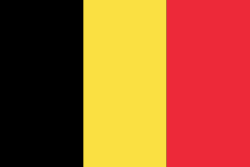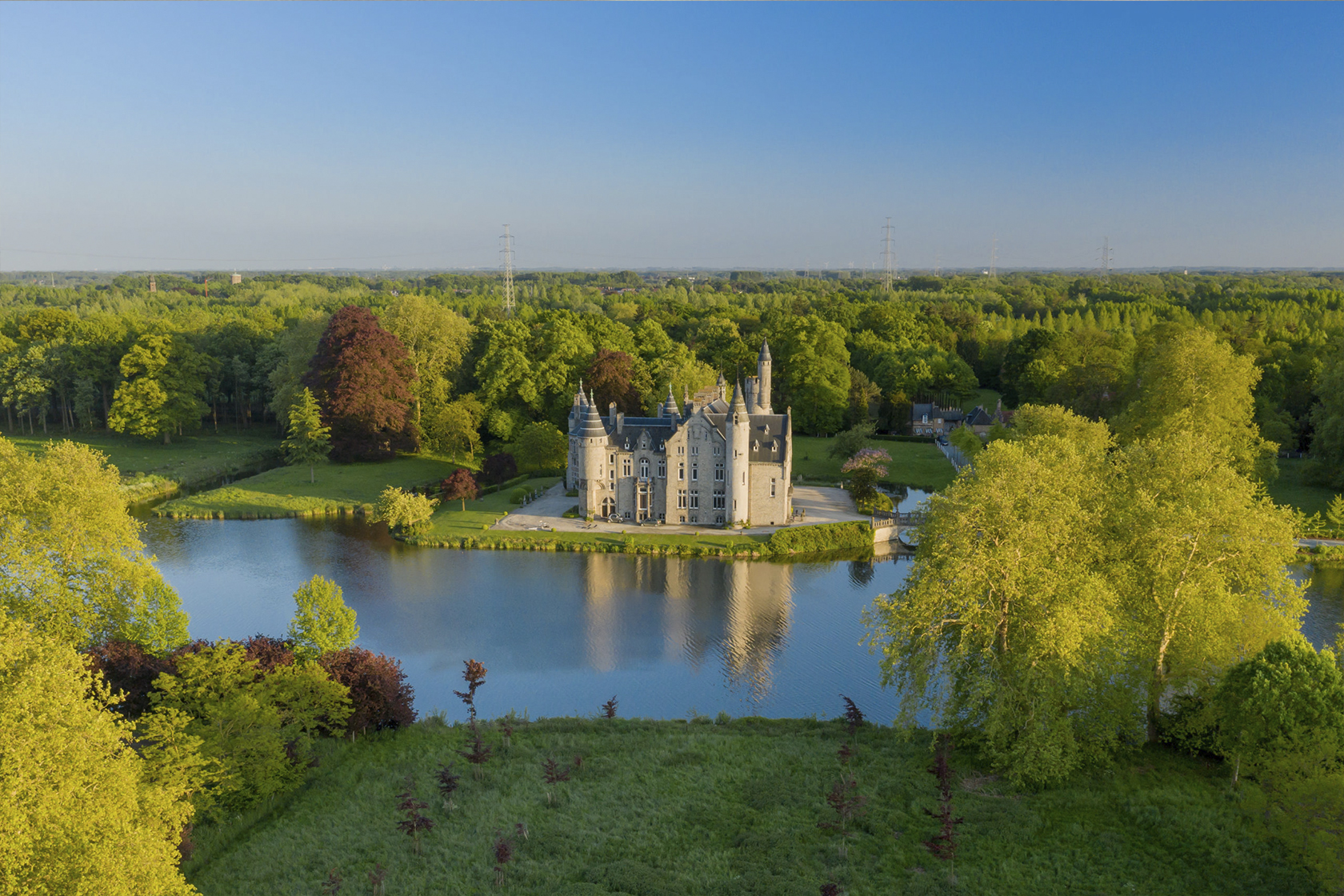CASTLE BORNEM
Situé à Bornem, au bord d’un ancien bras de l’Escaut, le château– propriété du comte John II de Marnix de Sainte Aldegonde – domine un vaste domaine boisé de 115 hectares. Habité par la même famille depuis 1780, il témoigne de plus de mille ans d’histoire.
PRESENTATION
Érigé au IXe siècle comme fortification contre les invasions normandes, le château devient au XIe siècle le siège des vicomtes de Gand, avant d’être intégré aux possessions des comtes de Flandre. Au XVIe siècle, Pedro Coloma, noble espagnol, y bâtit un château de style Renaissance. À la fin du XIXe siècle, à la demande du comte Ferdinand Joseph de Marnix, l’architecte Hendrik Beyaert créé une élégante demeure néo-Renaissance, entourée d’eau et de jardins à la française. L’intérieur brille par ses somptueux salons de styles Louis XV et XVI, ses remarquables collections d’art, dont des gravures de Pieter Bruegel l’Ancien, et ses bibliothèques renfermant manuscrits et incunables. Les visiteurs découvrent également le musée Philippe de Marnix, hommage à l’illustre conseiller de Guillaume d’Orange et le musée des attelages, installé dans les dépendances, avec une des plus belles collections de calèches du pays.
MUSEUM VAN BUUREN
The van Buuren Museum and Gardens, located in Brussels, is a magnificent Art Deco residence dating from 1928. Its perfectly preserved interior houses an exceptional collection of artworks from the 15th to the 20th century.
Surrounding the villa, the beautifully landscaped gardens offer a unique journey through landscape design.
The museum is administered by the Public-interest foundation The van Buuren Museum and Gardens, set up in 1970 by Alice van Buuren, and has been open to visitors since 1975.
PRESENTATION
Built by David and Alice van Buuren, this Art Deco villa reflects the influence of the Amsterdam School. Its refined interior, designed by Belgian, French, and Dutch decorators, showcases an exceptional mix of styles, with paintings, rare furniture, stained glass, and sculptures. Open to the public, this private museum is a true testament to the interwar period, embodying the van Buuren couple’s passion for art and culture.
The listed, award-winning gardens extend over 1.2 hectares. Originally designed by Jules Buyssens, and later enriched by Alice van Buuren with the verdant visions of René Pechère. The six distinct spaces, from the Picturesque Garden to the Labyrinth and rose gardens… each bringing a unique touch to this magical place.
ATTRE CASTLE
Nestled on the banks of the Eastern Dender and surrounded by a splendid landscaped park, ’Attre Castle is an exquisite 18th-century manor house. A fine example of neoclassical architecture, it is one of the rare Belgian châteaux to have preserved its original décor and furnishings. Recognised as a site of exceptional heritage in Wallonia, it remains the property of the de Meester de Heyndonck family.
PRESENTATION
Attre Castle, built in 1752 on the foundations of an older structure, was commissioned by Count François-Philippe Franeau d’Hyon, Count of Gommegnies. His son, François-Ferdinand, designed the interiors in the Louis XV style. As a chamberlain at the court of Archduchess Maria Theresa of Austria, he frequently hosted Archduchess Maria Christina of Austria and her husband, Count Albert of Saxony-Teschen, between 1782 and 1788.
In 1814, the château passed to the du Val de Beaulieu family and later, in 1910, to the de Meester de Heyndonck family. It is a remarkable example of neoclassical architecture, featuring a symmetrical and understated façade, a triangular pediment, and two lateral pavilions.
Its 17-hectare landscaped park includes several notable features, such as a 17th-century dovecote and an impressive artificial rock formation with a 33-meter-high tower and underground galleries.
BELOEIL CASTLE
Eight centuries ago, surrounded by its moats, Beloeil Castle was initially a medieval fortress. Over the centuries, it transformed into a pleasure castle and has been owned by the Princes of Ligne since the 14th century.
PRESENTATION
Acquired by the Ligne family through inheritance from the Condé in the 14th century, Beloeil Castle has undergone several architectural transformations, evolving from a defensive stronghold into a more comfortable aristocratic residence. While some foundations and towers still bear witness to its military past, the estate has been designed to reflect the elegance and refinement of its occupants.
The interior houses a remarkable collection of artworks from the 17th to the 19th century, including furniture crafted by the greatest French cabinetmakers of the 17th and 18th centuries, and an impressive library containing 20,000 volumes.
The estate is also renowned for its French-style garden, designed in 1664 and meticulously maintained according to its original layout. This 25-hectare park, harmoniously blending water and greenery, shade and light, is recognized as an exceptional heritage site in Wallonia.
PRIEURE DE BEAUFAYS
Nine centuries ago, a community of canons settled on a hill south of Liège, in a place known as “Belle-Fontaine”. They built a church, a keep, a priory, a farm, and a brewery.
Today, the main part of the estate still belongs to the Laloux family, who acquired it in 1890.
PRESENTATION
Founded in 1123, Beaufays Abbey has witnessed over nine centuries of history, first under the authority of the Bishop of Verdun, then under the Prince-Bishop of Liège. Following the French Revolution, the estate was sold in 1796. After passing through several owners and serving as a girls’ boarding school in 1875, the Liège industrialist Adolphe Laloux purchased Beaufays in 1890. He undertook major restoration works and designed stunning landscaped gardens.
Built in 1701, the current church is an architectural Baroque-style masterpiece. The estate also houses the recently restored Henri de Goha Pavilion, a jewel of Liège’s heritage, featuring a remarkable Louis XIV stucco ceiling adorned with oak and acanthus leaves.
Le domaine abrite également le pavillon Henri de Goha, un petit joyau du patrimoine architectural liégeois. Restauré en 2024, il est orné d’un plafond stuqué de style Louis XIV, aux motifs de feuilles d’acanthe et de chêne.
In collaboration with a local brewery, the abbey continues to make the “Prieuré de Beaufays”, an abbey beer inspired by centuries-old Augustinian brewing tradition.
BIOUL CASTLE
Set within 30 hectares of stunning countryside in Anhée, Bioul castle stands proudly above the Meuse Valley. A true architectural gem, it reflects both its medieval origins and its long-standing residential heritage. Owned by the Vaxelaire family since 1906, the fifth generation now passionately manages the estate.
PRESENTATION
Originally built in the 11th century as a defensive fortress by the d’Orbais family, the castle later passed through the hands of several noble families, including the de Jauche lineage and the Barons of Brandenburg. In 1554, a fire set by the troops of King Henry II marked a turning point, transforming it into a stately residence.
In the 19th century, François Vaxelaire, founder of the “Au Bon Marché” department stores, purchased the castle and undertook major renovations. Since 2015, Bioul has been revitalised with the creation of an organic and biodynamic vineyard, making it a must-visit destination for wine tourism.
GARDENS OF ANNEVOIE
Built in 1758, Annevoie Castle is nestled between Namur and Dinant and is renowned for its breathtaking water gardens. Since 2017, the estate has been managed by a private foundation established by Ernest-Tom LOUMAYE and his wife, to restore and preserve this exceptional architectural and landscape heritage.
PRESENTATION
Annevoie Estate was founded in 1758, thriving on the prosperity brought by the iron industry. His travels inspired Charles-Alexis de MONTPELLIER to design gardens seamlessly blending French, Italian, and English styles. Spanning around twelve hectares, the gardens feature a remarkable network of ponds, canals, and over fifty fountains and waterfalls, all functioning naturally without machinery. The historic vegetable garden has also been beautifully restored.
As one of the best-preserved water gardens in Europe, Annevoie holds prestigious titles such as “Historic Monument,” “Exceptional Heritage of Wallonia,” and “Remarkable Gardens.” It has also been awarded two stars in the Michelin Guide.
CITADEL OF DINANT
Perched atop a rocky promontory, Dinant Citadel offers a stunning panoramic view over the River Meuse.
Owned by the de Villenfagne family, this historic fortress takes visitors on a journey through 1,000 years of history.
PRESENTATION
The first fortifications were built in the 10th century to protect the Meuse Valley and the town of Dinant. The current citadel, constructed by the Dutch in 1818, stands on the foundations of earlier medieval structures.
Dinant’s past has been marked by key historical events, including the sacking of the city by Charles the Bold in 1466, the fortification works by Vauban, Louis XIV’s renowned military engineer, and the fierce battles between French and German forces during World War I. In August 1914, 674 civilians lost their lives in a tragic massacre.
Immersive exhibits and a dedicated World War I museum space allow visitors to relive these dramatic events.
FREYR CASTLE
Nestled along the Meuse River near Dinant, Freÿr Castle was originally a fortress before evolving into a magnificent Renaissance residence.
Passed down through the Spontin, Laubespin, and Bonaert families, the estate is now managed by the Domaine de Freÿr non-profit organisation.
PRESENTATION
Originally built in the 14th century by Jean d’Orjo, Freÿr Castle was destroyed in 1554 and rebuilt in 1571 by Guillaume de Beaufort-Spontin.
In the 17th century, Hubert de Spontin transformed it into a Renaissance-style country residence and designed its gardens, which were later redesigned in the French style in the 18th century.
In 1675, it hosted negotiations between Louis XIV and Charles II of Spain, leading to a trade agreement restoring commerce along the Meuse.
After turbulent post-revolutionary times, the castle flourished once more before being requisitioned as a German military hospital in 1914.
Restored after the war, it was opened to the public in the late 1940s. Its stunning gardens, with terraces, fountains, and centuries-old orange trees, offer breathtaking views of the Meuse.
HOF BLADELIN
Nestled in the heart of Bruges, Hof Bladelin is a magnificent medieval city palace with a rich history shaped by art, faith, and trade.
Since 1964, it has been under the care of the Congregation of the Sisters of Our Lady of the Seven Sorrows, Ruiselede, who are dedicated to preserving this remarkable heritage.
PRESENTATION
Stepping into the enclosed garden of Hof Bladelin is like travelling back to the Burgundian era of Bruges. Originally built for Pierre Bladelin, Treasurer of the Order of the Golden Fleece, the residence was later expanded by Piero de Medici, a member of the renowned Florentine banking dynasty, and further extended in the 16th century by the influential Egmont family.
Over the centuries, Hof Bladelin served as an aristocratic residence and, between 1632 and 1669, housed a Carmelite convent.
Around 1830, Abbot Léon de Foere established a religious institute for the poor, founded a lace school, and commissioned a neoclassical chapel. He also adorned the audience hall with monumental frescoes—faithful reproductions of Raphael’s Vatican murals.
LOPPEM CASTLE
Loppem Castle, near Bruges, is a stunning neo-Gothic masterpiece from the mid-19th century. Set within a vast park with ancient trees, ponds, and a labyrinth, it offers a unique historical and architectural experience.
In 1951, Baron Jean van Caloen established a foundation to preserve the castle, its furnishings, park, and outbuildings while promoting its rich art collections.
PRESENTATION
Designed as a complete work of art, the castle seamlessly blends exterior and interior elements. The English architect Edward Welby Pugin created the furniture, while Jean-Baptiste Bethune designed the interiors. Skilled local craftsmen crafted the stained glass, chandeliers, staircases, and fireplaces.
The ground floor features elegant reception rooms that reflect 19th-century grandeur, while the upper floor houses the family chapel and royal chambers. These rooms recall the castle’s prestigious past, including the stay of King Albert I and Queen Elisabeth in 1918, shortly after the First World War. The ground floor features elegant reception rooms that reflect 19th-century grandeur, while the upper floor houses the family chapel and royal chambers.
The castle displays medieval, Asian, and African art collections assembled by Jean and Roland van Caloen.
These rooms recall the castle’s prestigious past, including the stay of King Albert I and Queen Elisabeth in 1918, shortly after the First World War.


























